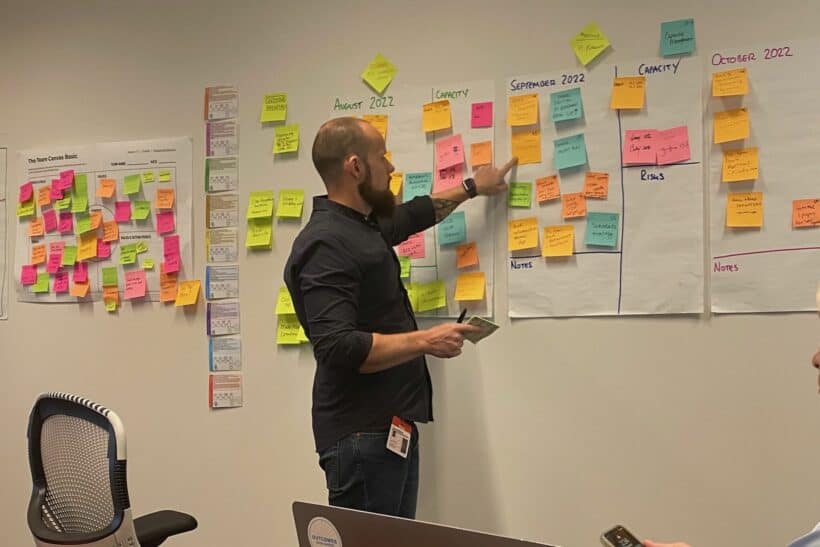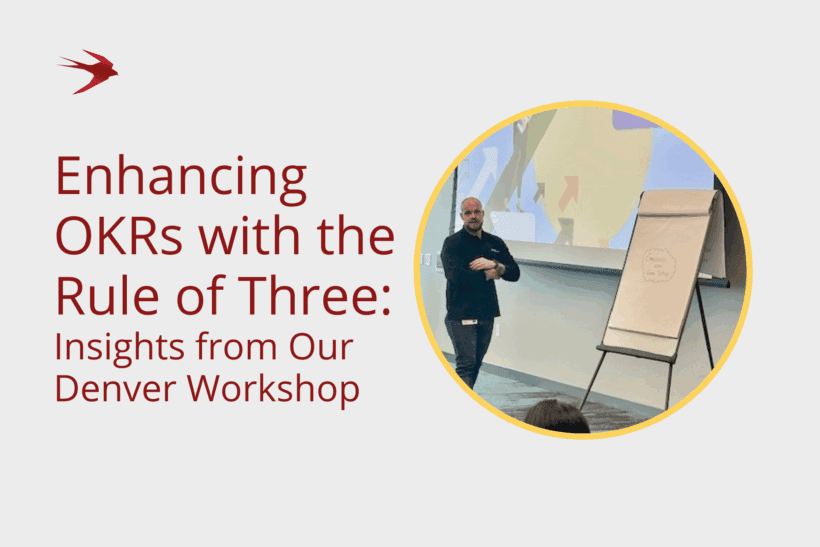Over the last 18 months, we’ve had the privilege of working closely with an independent public charity in the USA, assisting them on their journey towards embracing agile practices. From launching multiple agile Release Trains (ARTs) to conducting Value Stream Mapping workshops and more, we witnessed the tremendous success of their agile transformation.
As the organisation achieved new heights of agility, they recognised the potential to unlock even greater value across the entire organisation. This realisation paved the way for the adoption of Lean Portfolio Management (LPM) practices, a critical step to further enhance value delivery and strategic alignment.
At the heart of this new endeavor lay a crucial objective – to improve alignment from top to bottom, aligning strategy with execution across the portfolio. In our experience as agile consultants, we’ve encountered common challenges when guiding companies through the adoption of Lean processes and tools at the portfolio level.
What are the Typical Challenges in Relation to Lean Portfolio Management?
We often see similar challenges around strategy and execution alignment when working with companies to adopt lean processes and tools at the portfolio level. Some of these challenges are:
Lack of Reliable Data: Many organisations struggle to confidently identify the most significant improvement opportunities due to a lack of reliable data across their portfolio.
Prolonged Strategy Development: Lengthy strategy development processes hinder timely decision-making and hypothesis testing, delaying valuable progress.
Inconsistent Agile Adoption: When agile practices vary widely across the portfolio, miscommunication and bottlenecks arise, hindering collaboration.
Lack of Clear Link to Enterprise Strategy: Solutions being created may lack a clear connection to the broader enterprise strategy, leading to misalignment.
Centralised Strategy Development: Centralised strategy development limits broader understanding and buy-in from those contributing to its realization.
[Case Study] How We Elevated Portfolio Performance by 9% >
Insights from Industry
It is not just the companies that we work with who are trying to improve alignment in their portfolio. During our visit to the 2023 Business Agility Conference, we heard a great talk on how Amazon Web Services (AWS) sought to better align strategy and execution, with a customer focus. We’ve shared our key takeaways below or you can watch the full talk for yourself:
One of our takeaways from the talk was reframing the identity and objectives of the function to “APEX” for Analysis, Planning, and Execution. We can see how creating an identity of shared ownership across departments can eliminate silos. In organisations that we have experience helping, APEX could include strategy, PMO and execution.
A second takeaway is thinking about strategy as a series of two-way doors. A well-defined strategy is crucial to the success of any business, yet we have experienced many approaches to strategy that are unresponsive to change and span multiple years. Treating strategy development incrementally, as a series of two-way doors, enables you to experiment continuously as the strategy evolves. The strategy does not need to be developed in a linear, big bang approach.
Finally, how do you involve your customers and stakeholders in strategy development? In agile, there is a big focus on bringing the customer to the centre of everything we do, to facilitate the flow of fast feedback. What is stopping you from operating the same way within strategy development?
“We don’t do strategy to our customers. We want to do it with them.”
Awais Sheikh, Head of Planning and Execution Management for Federal Nonprofit and Healthcare at Amazon Web Services
How to Improve Alignment Between Strategy and Execution
Consider these tips when looking to improve alignment between strategy and execution within your portfolio and organisation.
Visualise the Portfolio
When implementing Lean Portfolio Management practices with a client, one of the first things that we do is visualise the current state of the portfolio. We find that this is best done using a virtual collaboration whiteboard, or with post-it notes if you are in the office.
We work with stakeholders to plot their current work considering two things:
- Current state, for example, not started, started, stuck, etc.
- Alignment to a strategic priority
This will enable you to:
- Understand the current state of the portfolio and how the work contributes to the overall strategy
- Add insight into prioritisation discussions
- Build an appreciation for all of the work that is currently being executed
- Challenge yourselves on your current work in progress (WIP). Are you trying to do too much? In our experience, the answer is always a resounding “Yes”
- Move toward implementing a Portfolio Kanban to facilitate flow throughout the portfolio
Overcommunicate the “Why”
A common frustration that we hear from teams is they do not understand how the work that they are doing contributes to the enterprise strategy. To avoid this, ensure that you have:
- A clearly defined vision that inspires action. Ensure that you are painting a compelling case for change and highlight how this impacts the people affected by the change
- Clear hypothesis statements at all levels of work, giving the people contributing to the execution of the strategy a clear goal of what they are trying to achieve and why
- SMART Objectives and Key Results (OKRs) defined to keep people focused on outcomes over outputs and help you keep the small wins along the way related to the big wins that we are trying to achieve
Take a Cross-Functional Approach to Strategy Development
Ensure alignment from the start by taking inspiration from AWS’s approach mentioned earlier in this blog post. Bring your customers and people from execution into the strategy development process early and often to provide valuable feedback. You can treat strategy development with a start-up mentality, a series of short iterations with clearly defined minimal viable products (MVP) that will validate your assumptions one by one as we move toward a shared understanding of the strategy.
We helped one of our clients take this concept to a new level by hosting a two-day strategic development and planning session with people from across their entire portfolio. This session was inspired by PI Planning, where leaders in the strategy team outlined their vision and objectives and the cross-functional teams collaborated on how they can contribute to the vision. This was a resounding success, leaving people feeling empowered, committed to the objectives and ready to inspire change.
Cultivate a Culture That Supports Experimentation
No matter how great your enterprise strategy is, the success of it is down to the people contributing to it. Empower your people to make decisions that will improve flow. Give them the autonomy to take the strategy and iterate towards fulfilling it. Encourage and cultivate an environment that supports experimentation. Be as transparent as you can with where you are as an organisation and where you would like to go.
Put your people before your process, not the other way around.
Supercharge Your Portfolio with Lean Portfolio Management
If you are looking for ways to supercharge your portfolio by aligning strategy and execution through implementing Lean Portfolio Management, get in touch for a free agile consultation today.


